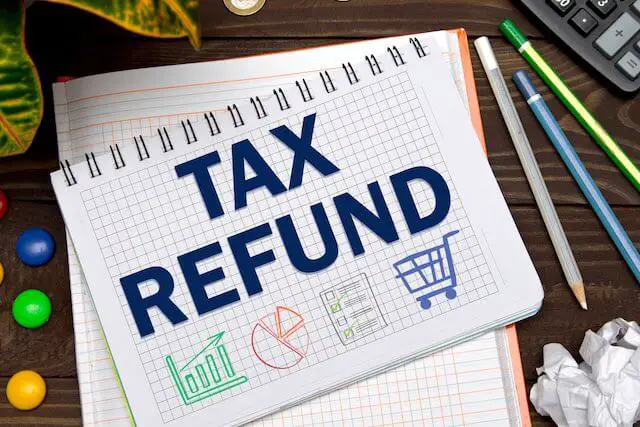After much political drama over the possibility of Americans getting lower tax refunds due to the Tax Cuts and Jobs Act, it turns out that refunds haven’t slipped after all. Recent data show that the average tax refund is up over last year by 1.3% to $3,143.
So why would I say this is bad news?
Bad Financial Planning
Tax refunds feel good on the short term, but they are bad for your finances on the long term.
Getting a refund feels good; it’s basic human psychology, and this probably explains why people clamor for them every year in April.
“A lump sum is valued over small periodic increments,” Francine J. Lipman, a tax law professor at the University of Nevada, Las Vegas, told Business Insider.
“The frustration with lower tax refunds because withholding was reduced is that taxpayers didn’t value the increased net pay during the year for a number of reasons, including it might have been offset with other increased costs like healthcare premiums, state taxes, local sales and property taxes, or payroll taxes, housing costs, food, etc. so that the net gain was minimal or perhaps they actually experienced less of a net loss,” Lipman said.
Despite the short-term euphoria you might feel with getting a big check in the mail, the problem is that you cost yourself money in order to get it. A tax refund means you are giving the federal government an interest free loan for a year with money that could be put to use in better ways, such as on needs for your family or saving it productively for your future.
“Santa Claus does not live in Washington,” says personal money-management expert Dave Ramsey. “If you get a $4,800 tax refund every year, you’re loaning the federal government $400 each month, interest free. They’re taking too much out of your check each month and they give it back to you, so you’ve lost the use of [nearly] $5,000 during that year that you could be using to get out of debt and/or build wealth. The government doesn’t give you money; they gave you your money back because you gave them more than you needed to for your taxes.”
Security Risks
As if that wasn’t bad enough, there are security risks associated with tax refunds as well in today’s world of identity theft and cybercrime.
Consumer advisor Clark Howard explains that tax refunds are targets for identity thieves: “Let’s say you are expecting a tax refund of a few thousand dollars, and somebody has filed false returns [in your name], you are going to have to wait 10-14 months for your legitimate refund while the IRS clears away all the mess from the fake tax return. So, there you were anticipating this money that you are [now] not going to have.”
So What Should You Do?
Adjust Your Withholdings
If you are getting a tax refund, it means you are having too much withheld from your paycheck. Ideally, you will withhold just enough money so that you owe nothing come tax time but also get no refund.
Keep in mind that just because you claim the proper number of exemptions it does not necessarily mean you will wind up owing no taxes at the end of the year.
“The IRS tables do not work all the time,” says Ramsey.
He advises that one simple way to determine your proper withholdings is to look at what your refund was last year, and assuming you have had no major life changes (i.e. having a child, buying a house, etc) that could impact your taxes, adjust your withholdings by the proper monthly amount.
Example: If you got a $3,000 tax refund, that means you overpaid by $250 per month ($250 x 12 = $3,000). You should adjust your W4 to claim enough exemptions to increase your take home pay by $250 per month to do away with the refund. Your human resources office as well as a tax advisor can help you in making these calculations for your situation, especially if your tax situation has changed in some way from the previous year.
Set up a Regular Savings Plan
Having a stash of money on hand is a good thing, but there are better ways to go about getting it and managing it than letting the IRS send it to you.
You were already putting away extra money every month to have gotten a tax refund in the first place, so why not make that money work for you by earning interest or getting you future tax breaks?
Howard suggests setting up an automatic savings plan that earns you interest or gives you future tax benefits: “If instead you go to your payroll office, reduce your withholding, and then take whatever that extra money is and put it automatically into either an online savings account, or better yet, a Roth IRA and start building tax free investment money for your future.”
Unlike money going to the IRS every month, money that gets put automatically into a savings account means it will earn interest, and you have it in your possession. Should you need it for some reason, such as a family emergency (car breaks down, somebody gets sick, etc.), it’s accessible anytime.
Roth IRAs grow tax free, so that means that you put money on which you have already paid taxes into them and you get to take it out at retirement without paying any additional taxes. If you invest the money in a mix of good mutual funds over a long period of time (i.e. your working career), this will add up to some serious money, especially if you put the max into the Roth IRA each year (currently starting at $6,000 per qualifying individual in 2019).
Bottom line: it’s your money, so use it to your advantage!


